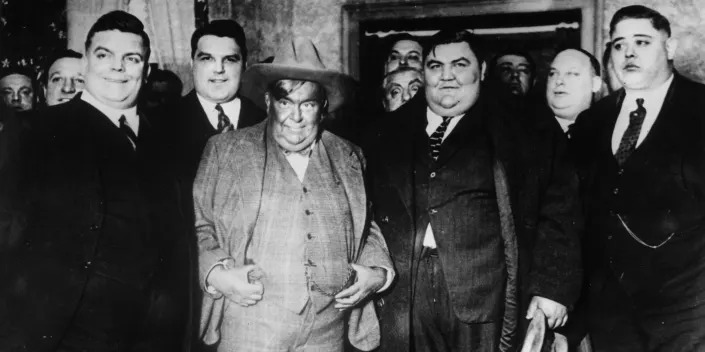
Men formed high society clubs based on their weight because rotund was seen as a status symbol in the US.
Fat Men's clubs popped up across the US in the early 1900s with one New England club having 10,000 members.
Nine-course meals and athletic contests were part of the club meetings.
High society clubs with a 200 pound weight minimum were formed by men who were proud of their big bellies in the 19th and early 20th century.
According to a report by NPR, clubs that celebrated excess popped up across the US.
According to a history of the New England Fat Men's Club written in Upper Valley Life Magazine, the club had over 10,000 members at one point. To be eligible, men had to weigh 200 pounds and pay a $1 membership fee.
"We're fat and we're making the most of it!" was the motto of the New England Fat Men's Club.
The New England Fat Men's Club is in session at Hale's Tavern, according to an article in the Boston Globe in 1904.
According to the article, the natives have stared with envy at the portly forms and rubicund faces which have arrived on the trains.
According to an Upper Valley Life Magazine excerpt, at their biannual club gatherings the men would eat from sunrise to sunset with athletic contests of leap-Frog contests, broad jumps, and races in between their multiple-course meals.
One nine-course menu included oyster cocktail, cream of chicken soup, boiled snapper, fillet of beef with mushrooms, roast chicken, suckling pig, shrimp salad, steamed fruit pudding with brandy sauce, assorted cakes, cheese and ice cream followed by coffee and cigars. The evening was full of laughter and wit.
The New England Historical Society said that there was more to the club than nine-course meals and friendly competition.
The Fat Men's Club offered membership to the former President but he declined.
The first meeting of the Fat Men's Association of New York City took place in 1869 and included city officials, lawyers, contractors, and sergeants with the New York Police Department.
Philetus Dorion, the association's president, gained 8 pounds from a clam bake held by the club in August 1884.
The Fat Men's Beneficial Association, the Heavy Weights, and the Jolly Fat Men's Club were all formed. The "Le Club des Cents Kilos" or "The Hundred Kilos Club" formed in France in 1897, but the group did not reach as high a level of success as the American clubs.
The club weigh-ins were a highly anticipated event, some being as competitive as they are at a modern day boxing match. According to Texas Monthly, men at a fat men's club in Texas cheated by stuffing weights in their pockets before stepping on a scale before a baseball game in 1920. The president of a fat men's club in Ohio would be decided by the weight of the members.
The fat men's clubs that existed in the past were built on the idea that being fat was associated with wealth.
The thinner and shorter our ancestors were, the less food they had to eat. Being the size of a cathedral tells others that you are someone of significance because power and wealth are attractive characteristics.
At the start of the Industrial Revolution in the late 19th century, attitudes toward weight being used as a status symbol began to change as an increasing number of people had jobs that weren't physically demanding.
According to his book "Fat History: Bodies and Beauty in the Modern West," doctors and insurance actuaries began to push preferability of being overweight to being underweight around 1910.
The fat man's world became smaller in the 1920s after health professionals began to understand the negative effects of being overweight. The New England Fat Men's Club ceased to exist in 1924 when only 38 members showed up.
You can read the original article.